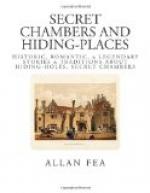The quaint discovery of rum at Stonyhurst suggests the story of a hiding-place in an old house at Bishops Middleham, near Durham, mentioned by Southey in his Commonplace Book. The house was occupied for years by a supposed total abstainer; but a “priest’s hole” in his bedroom, discovered after his death full of strong liquor, revealed the fact that by utilising the receptacle as a cellar he had been able to imbibe secretly to his heart’s content.
A large quantity or Georgian gold coins were found some years ago in a small hiding-place under the oaken sill of a bedroom window at Gawthorp Hall, Lancashire, placed there, it is supposed, for the use of Prince Charles’s army in passing through the country in 1745.
The laird of Belucraig (an old mansion in the parish of Aboyne, Aberdeenshire) was concealed after “the ’45” in his own house, while his wife, like the hostess of Chastleton, hospitably entertained the soldiers who were in search of him. The secret chamber where he was concealed was found some years ago in making some alterations to the roof. In it were a quantity of Jacobite papers and a curious old arm-chair. The original entry was through a panel at the back of a “box bed” in the wainscot of a small, isolated bedroom at the top of the house. The room itself could only be reached by a secret staircase from a corridor below. The hiding-place was therefore doubly secure, and was a stronghold in case of greatest emergency. The Innes of Drumgersk and Belucraig were always staunch Roman Catholics and Jacobites. Their representatives lived in the old house until 1850.
In another old Aberdeenshire mansion, Dalpersie House, a hiding-hole or recess may be seen in one of the upper chambers, where was arrested a Gordon, one of the last victims executed after “the 45.”
The ancient castles of Fyvie, Elphinstone, and Kemnay House have their secret chambers. The first of these is, with the exception of Glamis, perhaps, the most picturesque example of the tall-roofed and cone-topped turret style of architecture introduced from France in the days of James VI. A small space marked “the armoury” in an old plan of the building could in no way be accounted for, it possessing neither door, window, nor fireplace; a trap-door, however, was at length found in the floor immediately above its supposed locality which led to its identification. At Kemnay (Aberdeenshire) the hiding-place is in the dining-room chimney; and at Elphinstone (East Lothian), in the bay of a window of the great hall, is a masked entrance to a narrow stair in the thickness of the wall leading to a little room situated in the northeast angle of the tower; it further has an exit through a trap-door in the floor of a passage in the upper part of the building.
The now ruinous castle of Towie Barclay, near Banff, has evidences of secret ways and contrivances. Adjoining the fireplace of the great hall is a small room constructed for this purpose. In the wall of the same apartment is also a recess only to be reached by a narrow stairway in the thickness of the masonry, and approached from the flooring above the hall. A similar contrivance exists between the outer and inner walls of the dining hall of Carew Castle, Pembrokeshire.




